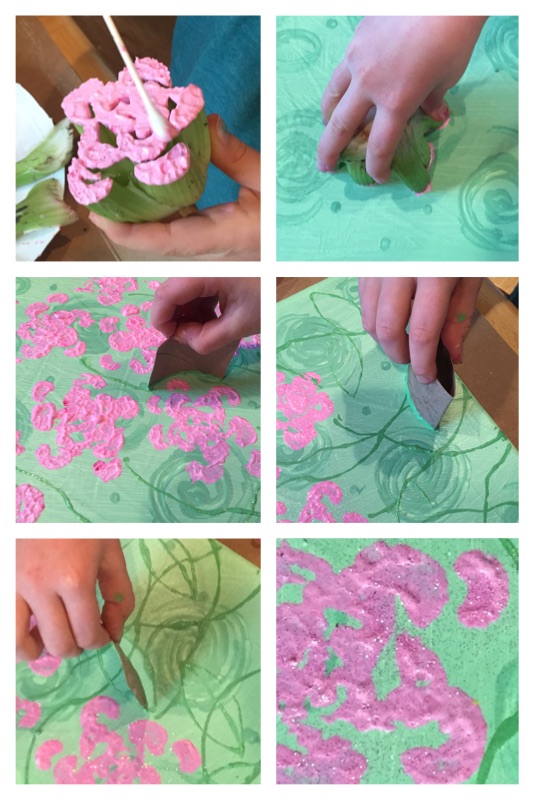
It’s the perfect time of year to give someone special a rose…or a rose print!
Celery Rose Printing Basics
This printmaking project uses simple materials to make a striking painting. It can also provide a visual (and very basic) introduction to the Fibonacci sequence present in nature. After cutting through the celery stalk, be sure to point out the spiral growth pattern of the branches. This spiral can be observed in other plants so if your little artist shows an interest be sure to foster it and follow up with looking for similar spiral patterns in other plants – perhaps start with an actual rose! (See more images of the Fibonacci sequence in nature here!)
Supplies:
- 1-2 large bunches of celery
- Cardboard tube from toilet paper or paper towels
- Paper plates
- Red and green paint (white and yellow optional for color mixing)
- Card stock – use folded card stock to make custom Valentine’s Day cards
- Small paintbrush or cotton swabs

Instructions – Set Up:
- Cut off base of celery about 3-4 inches from the bottom. The base of the individual branches should still be attached to the base, but spread out enough to see spaces between the cut ends. This spacing will create the appearance of petals – too close together and the “rose” will appear more like a solid blob!
- Pour red and green paint into separate paper plates covering a portion of the plate slightly larger than the width of the celery base. (We added a bit of yellow to lighten up the tone of our green.)
- Flatten the toilet paper tube, creasing the fold. Cut into 3 segments. Let the fold relax and as the tube “reopens” you will see the profile of a leaf shape. (See above.)
- Cut one of the other “leaves” along one fold so that it opens into a strip of cardboard. (See above.) This will be used to stamp the stem(s).
- Cut the third “leaf” along both folds. This will be used to stamp the center line of the leaves and to create short stems or fill in details as required.

Instructions – Printmaking:
- Dip the base of the celery in the red paint. Make sure all ends are covered in paint, but shake off excess or scrape off with small paintbrush or cotton swab.
- Place celery “stamp” on cardstock or canvas to create the rose. Press firmly then lift straight up (to not smear paint).
- Repeat (dipping the celery each time) for as many roses as desired.
- Taking the long strip of cardboard (the cut toilet paper tube) and dip the long edge in the green paint.
- Carefully place on the paper to paint the stem. We found it looked best leaving a small space between the end of the stem and the rose. (See above.)
- Dip the cardboard “leaf” in the green paint and place firmly on the paper to create as many leaves as desired, dipping the leaf in the paint between each print. (See above.)
- Dip the short strip of cardboard in the green paint. Very delicately place in the center of each leaf print to create a thin line down the center of each leaf reaching from one tip to the other. (See above.)
- Let dry for at least 2-4 hours, or preferably overnight, to make sure paint is completely dry.

Celery Rose Painting
My daughter was so inspired by the rose printing for Valentine’s Day cards she decided to take it to the next level and make a rose print painting for her room.
Supplies:
- 1-2 large bunches of celery
- Cardboard tube from toilet paper or paper towels
- Paper plates
- Red, white, green, and yellow paint.
- Small canvas or canvas panel
- Large paintbrush
- Cotton swabs or small paint brush
- Optional: fine iridescent glitter

Instructions – Canvas Preparation:
- Mix paint to create a background color. We chose a pale green to with her “bouquet of roses”/”flower garden” idea.
- Using a large paintbrush paint the full canvas and edges in an even coat.
- Using a slightly darker shade of green (or selected background color) add a pattern or texture. Inspired by Vincent van Gogh, my daughter decided to use thick paint strokes and swirls.
- Let canvas completely.

Instructions – Printmaking (same as above!):
- Dip the base of the celery in the pink (or selected flower color) paint. Make sure all ends are covered in paint, but shake off excess or scrape off with small paintbrush or cotton swab.
- Place celery “stamp” on cardstock or canvas to create the rose. Press firmly then lift straight up (to not smear paint).
- Repeat (dipping the celery each time) for as many roses as desired.
- Taking the long strip of cardboard (the cut toilet paper tube) and dip the long edge in the green paint. (Be sure to use a shade of green darker than the background!)
- Carefully place on the paper to paint the stem. We found it looked best leaving a small space between the end of the stem and the rose. (See above.)
- Dip the cardboard “leaf” in the green paint and place firmly on the paper to create as many leaves as desired, dipping the leaf in the paint between each print. (See above.)
- Dip the short strip of cardboard in the green paint. Very delicately place in the center of each leaf print to create a thin line down the center of each leaf reaching from one tip to the other. (See above.)
- To add a little sparkle, we sprinkled just a dusting of superfine glitter on the flowers. (This is going to hang in an 8 year old’s bright pink bedroom after all.)
- Let dry for at least 3-4 hours, or preferably overnight, to make sure paint is completely dry.

For more colorful printmaking activities, check out Geometry Prints for fun and easy techniques to create abstract compositions and clever drawing prompts.

Pingback: Exploring Positive & Negative Space – with Valentines! | Design in Play
Pingback: Simple Shapes & Custom Cards | Design in Play
Pingback: Spin Art with Snap Circuits | Design in Play